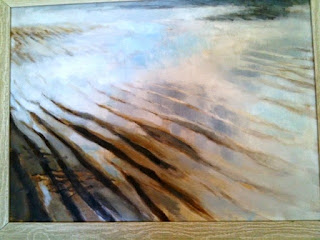Perhaps I should add in here … that in the early 1800s … it would take 40 hours from London to reach … St Ives, Penzance or Carbis Bay …
 |
| Cover image from Daniel Defoe's travels |
In those
early days of the 1800s … we’d have travelled by coach, possibly unsprung, with
lots of stops at coaching inns for vittling, changing of horses. Henry VIII (early 1500s) had established a
network of Posting Inns for his mail to be delivered wherever he happened to
be.

Sign at Whiddon
Down, Devon
The roads,
or tracks more like, would have been really terrible – as we were still using
those constructed by the Romans fifteen hundred years earlier. The Romans never conquered Cornwall … but
spread their wings, or more pertinently milestones, into the county.
Just an
interesting historical snippet in here – John Metcalf (1717 – 1810), who became
Britain’s first professional road builder – emerged during the Industrial
Revolution.
Believe it
or not he was blind from the age of 6 … but had an eventful life, living to the
ripe old age of 92 …

Statue of Metcalf in
Knaresborough, with
a Viameter
(Surveyor's Wheel)
… at age 77
he walked from Knaresborough to York, over 17 miles, where he related his life’s
work, in a detailed account, to his publisher.
We in the 20th century almost always drove … but occasionally I’d get the night sleeper from Paddington, London to Penzance.

Exeter St David's railway station
Or on one
occasion my brother and I were shipped (trained) off from Woking to Exeter … I
was guardian! – and had a ten shilling note or two sewn into the hem of my skirt –
for emergencies.

Ten Shilling note - I'd forgotten
about these ...
Another time
I’d been over in France with some of my mother’s first husband’s family at
their huge rambling holiday house in the Pyrenees – I must have been 14 … my
father came to Heathrow airport to pick me up … and as our own home was being
revamped, we’d decamped for our long summer holidays to the south coast of
Cornwall – rented a place … took the cats … and had a lovely time.

This is the most western
Ordnance Survey map of
Great Britain
Well, being
the good Girl Guide I was back then … we trundled our way down every nook and
cranny that the maps would allow us. It
took 10 hours!
We used all
the backroads, including ones with grass growing in their middle – it was fun
for me … my poor Dad – must have suffered bum ache!
One last bit
of nonsense … I can be so dumb at times … it had never occurred to me that our
original rail viaducts would have been made from wood … similar to the ones I
saw in Canada – but which weren’t in operation.
The particular one near where I was staying on Vancouver Island was the
Kinsol Trestle …
Kinsol Trestle - Vancouver Island
… here they
were rapidly rebuilt using stone: this one at Carbis Bay station – could be
used by travellers or ‘important people’ at the time of the G7 Summit in June.:(11th
– 13th June 2021).
Carbis Bay viaduct
The Eden Project - part of the 'showing off' bit
of the G7 Summit
Travelling
blog time over … Easter is a-coming … actually I’m rather enjoying the gentler
times without rushing here there and everywhere – but I will enjoy being free
again.
Have a
peaceful Easter weekend … and good luck to all the A-Zers …
Hilary
Melton-Butcher
Positive
Letters Inspirational Stories
















































